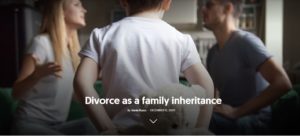In America, conservative Protestants seem to divorce at least as often as people of other religious orientations. The idea has become an opportunity for finger-pointing and accusations of hypocrisy, but this is only proof that the statistics are misinterpreted.
Many practising Christians rely on investing in their lifelong values, sincerely hoping that it will prevent them from ever reaching the brink of divorce. Their efforts in this direction are already well grounded in the American conservative culture, which we propose for analysis due to its exponent character, especially considering the export of this culture outside the United States.
Faith and practice
From adolescence, most conservative evangelical Christians promise to be abstinent until marriage.[1] Young people learn about the boundaries of a Biblical courtship[2]—what they can and cannot do during a romantic friendship[3]—and then they strive to respect them. They are taught to avoid pornography.[4] They are also taught not to jump from one relationship to another. They respect the institution of marriage and consider adultery to be something so serious that they cannot even joke about it.[5]
In this context, at the level of the entire population, the divorce rate in the predominantly conservative American states is higher than in those that are predominantly liberal.[6] This paradox has particularly intrigued sociologists, who have tried to determine why the pro-family discourse, so prevalent in conservative religious circles[7], does not decrease the divorce rate in areas with a significant number of such believers.
A mission for sociologists
Nicholas Kristof, in an editorial for The New York Times, cites research by Naomi Cahn and June Carbone that shows how a conservative state like Arkansas has one of the highest divorce rates in the US, while a liberal state such as Massachusetts has one of the lowest divorce rates. The two sociologists claim that liberal families “encourage their children to simultaneously combine public tolerance with private discipline, and their children then overwhelmingly choose to raise their own children within two-parent families.”
Alternatively, numerous studies have highlighted the fact that religious faith and participation in church life generally strengthen marriages and contribute to the improvement of relationships. This is another reason why the noticeably higher divorce rate in conservative states is intriguing. Nevertheless, sociologists have explored various mechanisms through which the influence of religious conservatism could be felt in connection with the risk of divorce.[8] Some of them noticed that, when elements that do not belong to religion per se, but are associated with it, are removed from the sociological equation, the trend no longer applies.
The domestication of statistics
The first explanation that sociologists put forward was that regions with a high concentration of conservative Protestants have other unique characteristics that are conducive to marital instability. In areas with many conservative Protestants, residents have, on average, a lower level of education.
On average, they tend to marry at younger ages. After getting married, they transition faster to parenthood and they also tend to have other children relatively quickly after the first one. In these regions, mothers have lower rates of integration into the labour market, and families have lower incomes.[9]
The family pattern in the conservative regions has been dubbed by sociologists the “red family model.” Unfortunately, most of these traits are individual risk factors for divorce[10], without stemming directly from religion. This first explanation claims, therefore, that the paradox is only apparent and is a result of a statistical interpretation that does not take into account the overall environment from which the data were collected.
A second explanation looks at the paradox through the lens of the much stronger marital culture in conservative states. In other words, residents of conservative states presumably have higher divorce rates because they also have higher marriage rates and lower cohabitation rates.[11]
In the “blue” states, the predominantly democratic ones, relationships that develop into cohabitation and break up are not registered as divorces, while in the “red” states, because the preferred type of union is marriage, the separation is much more visible in the statistics.[12]
Citing studies including his own, the American sociologist Bradford Wilcox argued that, if at the state level, the difference in the divorce rate puts Republican states at a disadvantage, at the individual level the statistics show the opposite. Republican families are more stable than democratic ones, spouses tend to declare themselves happy in marriage more often, they are less inclined to cheat on their partner, less willing to divorce, and less inclined to have the first child out of wedlock.
Wilcox seems convinced that these individual statistics are due to pro-family values, the economic prosperity that comes from sharing expenses with a spouse, and a certain Republican psychological pattern that he says is marked by optimism, conscientiousness, and risk aversion, all predisposing to a more stable marriage. The researcher insinuates that the statewide statistics are decisively influenced by the other non-conservative residents of the blue regions.
Values amplified and risks mitigated
Critics of the conservative Christian philosophy of life say that religious values are not enough to protect marriages, because “this religious culture both praises the sanctity of marriage while simultaneously eliciting patterns of behaviour that destabilise marriage.” The accusation blames the increased divorce rate on the education based on abstinence, intense familism, the high importance given to the idea of having children, the condemnation of abortion, and the disregard for contraceptive means.[13]
Critics suspect that all this contributes to the early formation of families and the end of formal education, both of which are factors that increase the risk of a marriage ending in divorce.[14] Presumably, encouraged to remain abstinent until marriage, the children of Protestants hasten the moment of marriage because it coincides with the desire to begin their sexual life. At the same time, because abstinence occupies a central place in education, they acquire insufficient information regarding the existing contraceptive means.
An early/out-of-wedlock pregnancy can also lead to an early marriage (something that doesn’t happen to the same extent in liberal states, where abortion is sometimes considered a contraceptive method). Moreover, because the family is formed early, the partners focus on the challenges of married life and no longer give importance to academic training and often give up their studies.
Even if the good values that must be preserved bring with them adjacent risks, there is no need to follow the path of those who, in an attempt to avoid them, have become their critics.
It is true that in the eyes of some, an untimely pregnancy born in an early, uneducated, and poor family increases the pressure that can make divorce seem the lesser evil. However, abortion is not and does not need to become a contraceptive method, no matter how much one protests against this idea. However, the other means of contraception must be known. In addition, treasuring family and children is an attitude worthy of the value that pertains to them. On the other hand, idolising family and stigmatising the unmarried or childless is extreme. There is no qualitative difference between a married person and an unmarried one, and our attitudes would do well to reflect this.
As for healthy sex education, it is not limited to anatomy or the mechanics of sex, but starts from knowing oneself and includes notions of emotional intelligence (Why do I feel what I feel? Why does the other feel what they feel? How does this influence the interaction between us?), concepts of emotional maturity (How do I avoid unhealthy dependence on the other? What about jealousy? What does it mean to have realistic expectations from a relationship?), and basic concepts of communication (What does intimacy mean and how is it built? What does consent mean?).
There are other important components of sex education, inextricably linked to religion, such as those regarding the legitimate framework— marriage—in which Scripture places human sexuality. When we pass on these moral values, “it’s got to be way more holistic,” claims the American author Anna Broadway, pointing out that restrictions are beneficial, and the idea of premarital chastity is positive, not negative—that is, it is the opportunity to emphasise the ideal of “self-giving love.” That’s why people should focus, she says, on enriching and building romantic relationships within the boundaries imposed by principles.
Effective education does not elude values as if the sum of taboos should be constant and therefore, if we have given up sexual taboos, we must have axiological taboos. In reality, values are worth preserving and affirming as such, recognising and avoiding the risks that come from ignoring the factors that interact with those values and which can divert them.
Alina Kartman is a senior editor at Signs of the Times Romania and ST Network.




















